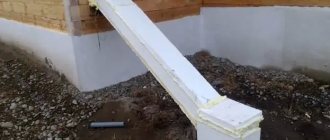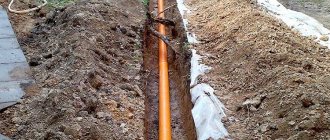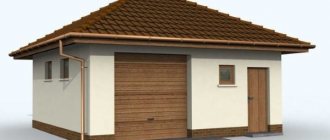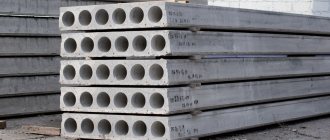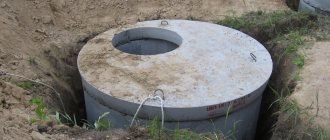How to choose the angle of inclination?
In the process of laying sewer systems, when considering the issue of sloping pipes, craftsmen resort to the correct methods for installing a slope; let’s look at what should not be done :
- Make a slope based on considerations of the formation of an acute angle of inclination. On the one hand, this method is convenient because the water will reach its destination faster. On the other hand, the operation of the pipe will be significantly reduced. Particles of debris, dirt or other impurities may remain in the pipe during rapid drainage, causing it to become clogged. In addition, fecal fractions will not be able to leave the pipe. Too large an angle or counter-slope will especially negatively affect the operation of the sewer system. Thus, this method is not entirely correct, since it is worth taking into account the minimum and maximum angle values. This is written in the regulatory documentation (see below).
- Arrange a minimal slope or do not take this point into account at all when installing sewer drains. The method is absolutely wrong, since ignoring the slope device will lead to stagnation of water.
Carry out the slope based on the requirements of standards and specialized literature. The surest way to follow.
Why calculate the slope?
By organizing the sewer slope, you can avoid:
Stagnation of water . A fairly common problem for everyone who has a sewer system.
Siltation . If this happens, then very soon the air siphons (check valves) will become unusable and there will be an unpleasant smell around. If a similar problem occurs on the walls of the main pipeline, the entire sewer system will break down.
Pipeline breaks.
Thanks to optimal fluid flow, no unwanted accumulation will occur. It will also be possible to get rid of corrosion on the surface of structures.
Previously, when installing sewer systems in apartment buildings, the slope of the sewer pipe by 1 meter was not calculated, and often it was not satisfied. This led to constant system breakdowns and regular repair work.
Providing a slope is required not only in urban apartment conditions. Recently, sewage systems have been installed in private homes and even bathhouses. Instead of ordinary cesspools, special wells (septic tanks) began to be used to receive wastewater.
Why do you need a slope angle?
In order for wastewater in the sewer to take dense particles with it, pipes must be laid at a certain slope. The angle of inclination must be set according to fixed, established SNiP standards. To reduce installation time or with the work of unqualified craftsmen, many end up with a sewer system that operates with irregularities or does not cope with the task at all:
- not paying attention to the fixed norm for setting the slope or when maintaining the slope angle at a value below the minimum, the operation of the entire system is disrupted. With such errors, water flow will be at a reduced speed. This will quickly clog the drain. The drain will need to be cleaned frequently. For example, when installing a toilet, measures to set the pipe slope in the correct position were ignored, then the remains of human activity will not be washed away thoroughly. They will begin to accumulate and decompose. This will lead to the rapid spread of an unpleasant odor throughout the living space;
- if the slope is significantly exceeded, then blockage cannot be avoided. Wastewater passes through communications at high speed, washing solid elements without taking it with it. This will lead to the accumulation of a fetid odor and spread throughout the house;
- If the established angle of inclination of the pipes is not observed, siltation of the main system will occur. The entire sewer system will stop working. An unpleasant odor will arise, and there will be a reason for replacement and cleaning;
- in an apartment building, in the absence of standards for setting the slope, a leakage or breakdown of communications may occur. All residents will have problems with drainage until the problem is resolved;
- plastic pipes installed in the wrong position will suffer from silting and blockages. Cast iron communications are susceptible to corrosion, which leads to leakage - all waste will penetrate into the basement, spreading a stench throughout the entire entrance.
Video on the topic:
Sewage slopes and their setting methods:
and video
How to choose the correct sewer slope:
Also, if there are no problems with corrosion during unsloped installation of plastic, then holes may appear in the cast iron pipe. It will begin to leak water and sewage into the basement.
Previously, in multi-storey buildings, sewers were not installed with a slope, which is why there were so many cases of flooding in an apartment on the first floor or a breakthrough of the entire sewer system.
Possible sewer slopes per 1 linear meter
Two indicators - the largest and the smallest - are determined by the diameter of the accepted pipes. The slope itself is calculated from the definition of one linear meter . So, for example, if the diameter of the structures is 110 mm , it is necessary to ensure a minimum slope of 20 mm (2 cm) . As the size increases, the angle of inclination of the sewer pipe decreases.
To calculate the slope of a sewer by 1 meter, it is necessary to calculate the ratio of its height to the length of the structure. Thus, with d50 mm and a structure length of 1 running meter. you will need to ensure that the bottom of the pipe is lowered by 0.03 m (3 cm) .
In simple words about sewer slope
The regulatory literature also specifies the maximum value of the slope, which should not exceed 15 centimeters per 1 m.
Calculation of pipe d110 mm for the installation of an external system
To understand the sequence of small calculations, it is worth solving one problem. Below we will consider the calculation of a sewer pipe slope of 110 mm for an external sewer to a septic tank , since this design is considered the most common when laying the system. If you read GOST, then the minimum slope of a sewer pipe is 0.02 m (2 cm) per meter.
To determine the slope angle, it is necessary to multiply the slope value from SNiP, SP or GOST with the length of the pipe (in this case 600 mm). Thus, the expression 6 * 0.02 = 0.12 m is obtained. Thus, a pipe 6 meters long d110 mm: the slope angle is 12 cm
Sewer slope
Using this formula, you can take into account any length of the pipeline, be it at least 10 meters or 400 centimeters.
Sometimes the slope is calculated in degrees, but often this perception is inconvenient. There are also online calculators to determine the desired inclination. They have a calculation program.
Useful - external sewage system
Why is slope needed and what does it depend on?
Unlike a plumbing system, sewage drainage through pipes is carried out due to natural gravity without pressure, so a slope is necessary for transporting it to the collection point.
The standards regulate the minimum slope values, established experimentally, taking into account various factors, so violation of the parameters in the direction of decrease will lead to incorrect operation and frequent blockages in the sewer system.
The angle of inclination of the sewer pipe depends on the following factors:
- Pipeline diameter: as it increases, the slope becomes smaller.
- Pipe material: when laying pipelines with a rough shell, due to high hydraulic resistance, the slope is made higher. Polyvinyl chloride (PVC) pipes used in the installation of individual household sewerage systems are considered hydraulically smooth; a concrete pipeline has the highest roughness.
- Sewer system designs: in a main line that has a large number of bends and turns, the hydraulic resistance is higher than that of a straight line; therefore, when laying it, a greater degree of slope is required.
Roughness of various pipes
Occupancy level
Sometimes standards require additional calculations, namely, determining the fill level coefficient. Calculation is required if the following materials are used:
- Plastic;
- Asbestos cement;
- Cast iron.
The fill level lets you know how fast the water should move to avoid possible clogging of the system. The fullness is calculated using the following formula:
Y=H/D
- H – water level;
- D – pipe diameter.
SNiP regulates two main pipe fill numbers - maximum and minimum. According to the documentation, Y=0.3 when it comes to the minimum indicator , and Y=1 when the structure is filled to the maximum . The last number indicates that there is no slope.
As for practical calculations, the pipe fill value usually lies in the range from 0.3 to 0.6. Often they take a value of 0.5 or 0.6, considering this number to be optimal.
The material of the pipe can affect how quickly it fills. For example, when using cast iron or asbestos-cement material for a structure, the filling of this structure will occur quite quickly, since the walls of the pipe will be rough.
An example of calculating the fill level of a pipe
The use of all the above formulas indicates the use of a hydraulic method for calculating the slope of pipes.
To make it clearer how to determine this coefficient, it is worth considering a clear example. Let’s assume that the initial data contains pipes with a diameter of 110 mm and a water rise height of H=60 mm. The coefficient calculation will look like this:
60/110=0.55. This number will be the desired Y .
Next, you should check the ratio of the calculated coefficient to the optimal water flow rate. The result should be within:
К≤V√Y
- K – coefficient of filling level. The optimal indicator, as already mentioned, is considered to be 0.5 for plastic pipes and 0.6 for other materials;
- V – flow velocity;
- √Y is the root of the previously determined indicator.
Based on the calculation results, it was determined that the found coefficient passed the test.
How to check the slope of a sewer pipe
To check whether the pipe is installed correctly, you need to use a building level:
An ordinary bubble is simply applied to the sewer pipe, and the position of the bubble will indicate the deviation of the pipe circuit from the horizontal.
On a note! Today on sale you can find special bubble levels designed for pipes. Made in the form of a half-clamp, they are firmly fixed to the pipes, which allows for more accurate measurements.
The hydraulic level consists of two measuring flasks connected to each other by a flexible hose, the length of which determines the area of the measured area. If you prefer the water level, you should get a partner, because... It's a little difficult to cope with alone.
An electronic laser level allows you to obtain the most accurate data with minimal effort and calculations.
Important! Only instrument data is used as a guide. Relying on the position of the floor is a mistake, because... its position, as a rule, initially has some deviation from the horizontal.
How to calculate the slope angle
In apartments and private houses, two types of pipes are used for laying sewer systems - 50 mm and 110 mm; an internal small-diameter pipeline leads from the installed plumbing - sinks, bathtubs, showers, kitchen sinks to a central riser or outlet pipe with a cross-section of 110 mm. The toilet is connected directly to a large pipe (110 mm) through corrugation or plastic adapter couplings of a similar size.
Even a junior school student can cope with the task of calculating the total angle of inclination of a sewer line; to do this, its total length in meters is multiplied by the standard slope indicator adopted for one linear meter.
For example, if the bathtub is located 3 meters from the central riser, then the height difference between the ends of the pipes entering the siphon and the riser should be 30 mm x 3 = 150 mm. It can be seen that the difference is quite large, so they tend to locate bathtubs, showers and toilets as close to the riser as possible. Siphons of sinks and sinks are located at a greater height from the floor level, so they can be carried over long distances from the riser.
When laying external sewerage, a pipeline with a diameter of 110 mm is used; usually the wastewater is discharged into a storage tank or septic tank for further purification. In this case, slopes play a decisive role in determining the distance from the house to the treatment plant, which is discussed in the examples below.
In a standard septic tank, the neck is located approximately 600 mm above the tank into which the sewer pipe enters. This means that if the pipe extends from the house along the very surface of the earth, and the 110 mm sewer pipe should have a slope of 20 mm per linear meter, then the septic tank will have to be placed at a distance of (600 mm / 20 mm = 30) 30 m from the house. The maximum distance can always be made smaller by increasing the pipeline slope by a certain amount, but for various reasons it is undesirable to do a rapid gravity flow.
To protect the sewer pipe from freezing, it will have to be insulated and lowered underground at the base of the building by at least 200 mm, in this case the septic tank will have to be brought closer to the house by 10 m. With a greater depth of the external sewer pipe with a higher chance of protection from freezing, to for example, at 400 mm, the distance from the house to the septic tank will be only 10 m.
Slope angle calculation options
In practice, two methods are used that allow you to easily calculate the angle of inclination of the pipe:
- non-settlement;
- calculated
The non-calculation method makes it possible to determine the height difference on a specific section of the pipeline depending on its diameter. The average value of this parameter is approximately 3% and may vary based on operating conditions.
The calculation method is intended for sewer systems with constant wastewater pressure. It is carried out based on one of two calculation methods:
- using the Colebrook-White formula;
- by determining whether the speed of movement of wastewater through pipes corresponds to the standard coefficient.
For private houses, the use of formulas is difficult, since it is impossible to know the degree of filling of the pipeline and the speed of fluid movement through it without the presence of special equipment, which professionals use in their work when calculating the angle of inclination. Therefore, the slope of pipes in individual households is calculated using a non-calculation method.
Determining sewer slope without formulas
When installing an external or internal sewer network without using complex formulas, use values with a set limit. This is the maximum and minimum slope for sewerage.
When laying an external highway, the slope is made at least 0.015 m per linear meter. Based on this indicator, intra-house pipe distribution is carried out, except for short sections of less than one meter in length. In this case, a value of 0.01 per meter will be sufficient. If you do not adhere to this parameter, solid fractions will settle on the inner surface of the pipes and cause them to clog.
The maximum slope of the external sewer depends on the speed of movement of the wastewater inside the pipe. So, for plastic pipes this parameter should not exceed 1.43 m/s. If the speed increases, the wastewater is divided into fractions, as a result of which solid particles begin to settle. The maximum slope should not be more than 3%.
Calculated and optimal pipe filling level
Pipe fillability is an indicator that describes the recommended speed of water flow in the pipe cavity for unhindered drainage of wastewater.
In order to make it clear why this indicator is needed when calculating the slope of the sewer system, it is worth noting that the speed of the water flow is directly related to the angle of inclination of the pipe.
The fillability of the pipe is characterized by the calculated and optimal level of wastewater flow. The formula for determining the estimated occupancy is as follows:
| Y = h ⁄ d , where: | |
| |
The minimum permissible occupancy level (according to SNiP) Y = 0.3. This means that the internal cavity of the sewer pipe must be filled to 1/3 of the total volume. In practice, the indicator varies from 0.3 to 0.6. It all depends on the pipe material, and the following table shows this:
| Pipe material | Optimal filling level |
| Cast iron | 0,6 |
| Asbestos cement | 0,6 |
| Ceramics | 0,5 |
| Plastic | 0,5 |
Having studied the theory, let's consider the practical application of the calculations:
- Let's say you need to calculate the maximum permissible flow rate of wastewater in the sewer system. It is known that according to standards, the speed of fluid movement for optimal functioning of the system must be at least 0.7 m/s.
- In our case, the height of the liquid in the pipe is h = 60 mm, and the pipe diameter is d = 110 mm, the material is PVC.
- Calculated fullness level Y = 60 / 110 = 0.55.
- At the next stage, the verification formula K ≤ V × √ Y is used, where: K is the optimal filling level (0.5 for plastic pipes); V is the speed of fluid movement (we take 0.7 m⁄s as a minimum); √Y is the square root of the calculated pipe filling capacity. We get: 0.5 ≤ 0.7√ 0.55 = 0.5 ≤ 0.52.
The calculation confirms the correctness of the specified sewer slope, at which the flow velocity is 0.7 m⁄s. In practice, the initial data are determined individually by calculation and compared.
Slope when installing internal sewerage
For the installation of internal sewage systems, pipes made of PVC material with diameters of 50 mm or 100 mm are used. During the connection process, the following permissible requirements must be taken into account:
- If there are branches located in a horizontal plane, an oblique tee or cross must be mounted between them. These designs are representatives of fittings. Also, these structures are necessary for organizing differences. In their absence, problems will arise with the safe supply of water to the main drain.
- Horizontal turns of the sewer system are prohibited. Turning sections should not form a right angle.
- Right angles are only possible if the structures are connected in a vertical plane.
- It is recommended to take the standard pipe slope less than or equal to the maximum value - 1-2 cm per linear meter .
- The outlet of the sewer system must be discharged outside the building on the side of the street where the common wastewater receiver (septic tank) is closest.
- A standardized distance must be maintained between the sewer and hot and cold water pipes.
- It is necessary to arrange a sunbed in the basement, to which it is necessary to connect the lines from all risers. Subsequently, the water will be directed to the nearest wastewater well.
Also, the slope value for domestic domestic sewerage may vary depending on the type of device. For example, for a toilet with a pipe with a diameter of 100 mm, the slope will be 1:20 (per 1 m/2 cm). As for the bathtub, 40 mm pipes are used for it, and the slope size is 1:30 (per 1 m / 3 cm). For a shower this ratio is 1:48, for a kitchen sink - 1:12.
The risers where pipes from household appliances are supplied have a diameter of 50 or 110 mm. The slope of a sewer pipe of 50 mm for internal sewerage is calculated for the risers to which the wiring goes from bathtubs and sinks. The slope of a sewer pipe of 110 mm for internal sewerage is calculated for the risers to which the wiring from the toilets is supplied.
But for the central riser, SNiP does not standardize a sewer slope of 1 meter.
Minimum pipe slope for external sewerage
The slopes of the external pipeline will be significantly less, due to the fact that the diameters that are laid outside the house start from 110 mm.
- For a pipe with a diameter of 150 mm, the minimum slope will be 8 mm per meter;
- For 200 mm, the slope will be 7 mm per linear meter.
The possible maximum for the external pipeline will be 15 cm/m, except for short sections whose length is less than 150 cm.
Organization of slope in a private house
It is worth noting that in a private house, wastewater disposal can be carried out:
- Pressure type. Pumps pump out wastewater, and there is no need to calculate the slope, since its purpose becomes meaningless. Solofits, or solofit in English, are sometimes used as pumps. These units are additionally equipped with special particle grinders. Pumps can also be used to remove feces. They have the letter F written on the body, indicating the brand and purpose (f70, f100). However, this method is quite expensive, so not many people resort to it.
- Gravity type. This method involves independent flow of wastewater through inclined pipes.
Read more in the article - Sewerage in a private house - step-by-step installation with your own hands
Non-calculation method for determining the angle of inclination
Using formulas, it will not be possible to determine the slope of the pipes of your own houses or dachas, since without special instruments it will not be possible to find out about the possible degree of filling of the pipes. Therefore, in order to determine the sewer slope of 1 meter for a private house, they resort to a non-calculation method.
This technique involves the use of the largest and smallest slope values. So, for example, for an external highway d110mm, a slope of at least 2 cm per linear meter is applied. As a result, this affects the organization of pipeline distribution indoors, and the optimal slope will be 0.02 per linear meter.
Nuances of installing external sewerage
The drainage of the intra-house sewer network is carried out through the hole provided for this purpose in the foundation of the house. This hole should be one size larger than the cross-section of the drain pipe. Those. with a pipe fitting diameter of 200 mm, the hole is cut to 400 mm. Such a gap is necessary to prevent damage to the sewer circuit due to shrinkage of the structure, while the opening itself is lined with a metal pipe.
The place where the sewer pipe exits from the foundation must be laid to a depth of 50 cm (not less than the level of soil freezing in winter). It is this mark that is the starting point for the future slope of the drain line. The location of the entrance to the septic tank serves as the final coordinate.
Installation work involves digging a trench strictly in accordance with the calculated data. In this case, the tendency of the soil to natural shrinkage should be taken into account, so the ditch should be carefully compacted. If this is not done, the soil will subside, and along with it the sewer pipe, as a result its position will change.
In addition, the bottom of the trench is covered with a sand cushion 20 cm thick, which is also compacted, spilled with water and leveled. After installation, the sewer pipeline is also covered with a layer of sand at least halfway and only then covered with ordinary soil.
Alternatively, the sewer line can be placed in a special concrete casing. This will not only ensure reliable fixation of the pipeline in a given position, but will also insulate it.
Important! Standards require the implementation of external sewerage in one section. However, if you still plan to switch to a different diameter, then a viewing well is installed in this place.
How to control the slope of a sewer pipeline
Control the slope using a building level. If the length of the section is particularly long, a bubble level can be attached in the middle of a long, even beam, with the help of which the work will go much faster.
Storm sewer and its slope
Storm drainage is necessary to organize the removal of water from the roofs of houses after precipitation in the form of rain or sleet. The main structures of the system are rainwater inlets. The slope of these structures is usually 0.02 m (2 cm).
It’s interesting, but sometimes this can include organizing the drainage of water from the air conditioner.
Installation features
In order to properly install storm drains, you must consider:
- Type of soil on the site;
- Average precipitation per month or year;
- Total drainage area;
- Location of underground communication systems.
If it is impossible to organize the installation of the sewerage system strictly according to the standards, the documentation allows you to reduce the slope of the rainwater drainage system by 2 millimeters for each meter of the system. The same thing happens when providing water drainage.
Maintaining the angle
The angle of inclination is half of the work. The main part is due to the maintenance of this indicator during the installation of the sewer system. Craftsmen use a special protractor.
If the protractor does not work, there is no way to get one; specialists make do with a simple level. There are a couple of methods:
- Draw a line on the wall corresponding to the degree of slope. Attach a building level and make marks in the area of the bubble. The pipe is installed relative to the position of the mark. The method is not ideal, as it allows for errors;
- attach a special pad to the meter level. The last element will correspond to the angle of inclination.
What should you follow when determining the slope?
If we take into account all the SNiP rules for organizing the inclination of sewer pipes, the general list will look like this:
- The maximum possible slope is 15 cm.
- When installing an external sewerage system, it is necessary to take into account the factor of soil freezing depth.
- When determining the slope of structures, it is recommended to seek the help of specialists and additionally check the calculations using regulatory literature. (possibly on your own)
- When installing a sewer system in a bathroom, you can resort to a minimum slope, since there is no risk of clogging the pipe with large particles.
- You can determine the slope using a bubble level. It needs to be laid in the place where the pipe is located, and depending on the position of the bubble, calculate the amount of inclination.
Also, before carrying out work, it is necessary to draw up a plan for the sequence of actions to avoid possible mistakes. The sewerage profile is also applied to the plan, and this item is prescribed by GOST 21.604-82.
If you take into account all the requirements of the documents, you will be able to organize a sewer system and ensure a normal slope with your own hands.
When it is impossible to maintain the desired tilt
When installation is accompanied by difficulties and it is not possible to maintain the correct angle of inclination, take the following actions:
Calculations that are within the permissible deviations can be used when laying a sewer system. It is important to make additional tees at a certain distance. Cleaning will be carried out through them.
In difficult areas, make elevation changes. Organize them by installing additional wells. With their help, lay communications properly, observing fixed standards. The number of wells may vary. From one to several. Depending on difficult cases, the length of the sewer.
If it is impossible to maintain standard indicators and the operation of the system will not be ensured properly by gravity, then you need to install a fecal pump. The device is suitable both for a specific sewer branch and for the entire system as a whole.
When laying plastic pipes, owners will be sure that cleaning will occur much less frequently than in the case of a cast iron system. Plastic pipes have a smooth inner surface, which ensures rapid sliding of drains. Cast iron does not have a perfectly smooth surface. Due to the presence of small notches and particles, waste will stop and grow faster.
What documents should I pay attention to?
First of all, the main document is SNiP. There will be several such documents. The main decisions and requirements for the design of the sewer system can be gleaned from:
- SNiP 2.04.01-85 “Internal water supply and sewerage of buildings.”
- SNiP 2.04.03-85 “Sewerage”.
- SNiP 3.05.04-85 “External networks and structures of water supply and sewerage.”
Additionally, you can study reference educational literature, teaching aids and recommendations for laying sewer pipes and organizing their slope.
Main settings
When laying sewer pipes with your own hands in a private house, it is very important to create the correct slope, following all the rules when installing them. Too little slope will result in weak flow within the line, which will allow heavy components to be deposited and subsequently require repair of all networks.
A large angle of inclination of the sewer pipe is also not suitable, since in such conditions wastewater will flow away faster than other components, which will also lead to clogging of the entire system and will have to be dismantled to correct the situation.
The rules for properly laying a sewer pipeline are to ensure sufficient speed of movement of wastewater. This indicator is one of the main ones, and it determines how efficiently the entire sewage system works.
The size of the pipe slope depending on its diameter
The statement that the greater the slope of the pipe, the faster the flow moves, and the better the performance of the entire system, is erroneous. With a large slope, indeed, the water will flow away very quickly, but this is the mistake - with the high-speed passage of water in the line, the self-cleaning of the system is significantly reduced.
Large and heavy particles that fall into the sewer along with water will not have time to travel the entire way and will remain in it, gradually accumulating and creating blockages.
In addition, this approach leads to noisy operation of the waste system, and due to the high speed of movement, increased wear of the internal surface will occur.
This will lead to premature replacement of individual sections or the entire sewer system will have to be repaired.
According to the rules for installing sewer pipes, the optimal speed of movement of wastewater should be from 0.7 to 1 meter per second.
Since the speed of movement of wastewater is set by the slope of the sewer pipes, there is another parameter, which is expressed by the difference in height at the beginning of the pipeline (the highest point) and its end (the lowest point of the entire system).
The slope per 1 linear meter of sewer pipes in centimeters in height is the parameter that must be observed when laying sewers. You will have to adhere to the standards for this value, since otherwise it will be necessary to dismantle the entire system, and sometimes repair or alter the water supply system.
Standards
When laying sewer pipes in a private house, you must follow the rules described in SNiP 2.04.01-85.
Optimal angles of inclination of sewer pipes according to standards
Taking into account the diameter of the pipeline, the sewerage is laid with a certain slope for each linear meter.
For example:
- if lines with a diameter of 40-50 mm are used, the slope should be 3 cm per linear meter;
- for pipes with a diameter of 85-110 mm, a 2-centimeter slope per linear meter is optimal.
In some cases, slope parameters are expressed as a fraction rather than in centimeters per linear meter. For the above example (3/100 and 2/100), information on the slope for the correct installation of sewer pipes in a private house will look like this:
- for lines with a cross section of 40-50 mm – slope 0.03;
- for lines with a cross section of 85-110 mm - slope 0.02.
Calculation table for pipes of different diameters
| Device | Slope | Distance between drain and siphon, cm | Diameter, mm |
| Bath | 1/30 | 100-130 | 40 |
| Shower | 1/48 | 150-170 | 40 |
| Toilet | 1/20 | up to 600 | 100 |
| Sink | 1/12 | 0-80 | 40 |
| Bidet | 1/20 | 70-100 | 30-40 |
| Washing | 1/36 | 130-150 | 30-40 |
| Bath, sink, shower (combined drain) | 1/48 | 170-230 | 50 |
| Central riser | 100 | ||
| Branches from this riser | 65-75 |
Let's take, for example, the installation and removal of a sewer pipe from a toilet. Here it is best to use a pipe with a diameter of 100.
As you can see in the table, the slope according to SNiP is 1/20, which means 1 meter divided by 20, for a total of 5 centimeters for each linear meter of pipe.
In this way, you can calculate the required slope for absolutely any plumbing fixtures.
Please note that when installing a sewer system, it is worth considering where you are running it from. For example, it is not recommended to use pipes with a diameter greater than 50 millimeters for washing, and for a toilet – a maximum of 100 millimeters.
Formation of runoff and its composition
Water collection is carried out by connecting the system to each console of the water supply network. The objects of flow formation are:
- The kitchen sink is the “supplier” of the most harmful formations for the wastewater system – solid kitchen residues and greasy deposits. From a sink with a siphon, a flexible corrugated tube drains the drain into a sewer pipe with a diameter of 32 - 50 millimeters. Pipes of a smaller diameter can have a sewer slope of 50 millimeters per 1 meter.
- The next object in the gravity drain network can be a washbasin. This is also a source of high-risk wastewater, supplying the most unpleasant thing to the drain - hair. When mixed with grease from the sink, they create strong, difficult-to-break plugs. For their unhindered removal, a sewer pipe slope of 50 millimeters per meter of length is created with an internal pipeline diameter (DN) of 32.
- The third drain object is the bathroom. It is connected to the sewer through a double siphon for the drain and overflow holes.
- The apartment wastewater network also includes a toilet that produces fecal waste.
The entire system of intra-apartment wastewater system consists of pipes of the required diameter, mounted with the same angle of inclination throughout. The total length of the sewer network is usually no more than 6 meters, which, with a sewer pipe slope of DN 50 in an apartment, is 18 cm.
Cast iron sewer pipes were traditionally used to install a drainage system in an apartment. This material is resistant to corrosion even when passing through fairly chemically active fecal waste.
Pipe connections were made through a socket, in which a rubber seal in the form of a ring is installed at the factory. After installing the pipe into the pipe, the connection was caulked, which required the use of malleable types of cast iron, a representative of which is nodular cast iron.
Plastic pipes, which gained popularity in the 90s of the last century, are increasingly replacing traditional materials, being more technologically advanced in installation, lightweight and quite reliable. The pipeline elements are connected in the same way using silicone sealant.
Watch the video
Laying sewer pipes - Slopes, connections, diameter and much more.
Sewage systems usually use pipes of sizes: DN 40, DN 50, DN 80 and DN 100 millimeters with internal sewerage slopes per 1 meter according to SNiP from 0.035 to 0.02. In this case, a size of 100 millimeters is used for installing a common section at the convergence of the sewer system lines.
